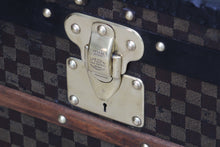
This antique Louis Vuitton Damier trunk from the 1880s is a remarkable piece of history, showcasing the luxury and craftsmanship synonymous with the brand. The trunk features the iconic Damier pattern, a checkerboard design that predates the famous LV monogram. Its exterior is adorned with vibrant original red paint, adding a striking contrast to the pattern. Notably, the sides are emblazoned with the initials 'MS' and 'N.Y.,' indicating a connection to New York City. The trunk is bound with sturdy steel edges, ensuring durability and longevity. It features a prominent brass lock, a hallmark of security and elegance in Louis Vuitton's designs. The interior of the trunk is complete and well-preserved, including all its original trays and steel locks. This antique piece is in very good condition all around, reflecting its careful preservation and the timeless quality of Louis Vuitton's craftsmanship.
How it all started...
In the serene village of Anchay, a young boy named Louis Vuitton often gazed at the distant horizons, dreaming of the grand city of Paris. His aspirations weren't of grandeur but of creation. He envisioned a new era of travel, defined by a trunk unlike any other.
Leaving his hometown behind, the young Louis embarked on a two-year trek to Paris. The journey was long, but every step was fueled by ambition. Upon his arrival in the City of Lights, he apprenticed under the esteemed trunk maker, Monsieur Marechal. Here, amidst wood, leather, and tools, Louis refined his craft, innovating and adapting.
By 1854, Louis had absorbed all that he could from his apprenticeship. The streets of Paris now echoed with his reputation, and it was time to make a mark. Louis Vuitton, the brand, was born at 4 Rue Neuve des Capucines. It wasn’t just another store; it was the birthplace of the flat-topped trunk. This ingenious design allowed for easy stacking during travel, a stark departure from the conventional domed trunks.
While his contemporaries were content with the status quo, Louis sought progress. He replaced the popular leather exterior with the Trianon canvas, a game-changing material that was both light and resilient. Yet, with success came imitators. Unfazed, Louis introduced the striped Rayée canvas and then the Damier canvas, always a step ahead of the counterfeiters.
The trunks weren't merely luggage; they were personalized companions for the journey. Louis and his growing team catered to the unique requirements of their elite clientele, crafting compartments for clothes, shoes, books, and even champagne. Every trunk was a piece of art, tailored to its owner.
The late 1800s brought a new challenge: the passing of Louis Vuitton. But his legacy was far from over. Georges, his son, honored his father with the Monogram canvas in 1896. More than a design, it symbolized the journey of Louis Vuitton - from a dreamer in Anchay to a legend in Paris.
As the world around evolved, so did the trunks. The essence, however, remained unchanged - a commitment to excellence, a spirit of innovation, and a legacy of Louis Vuitton himself. The trunks journeyed across continents, sailed across oceans, and witnessed history unfold, always a silent testament to Louis Vuitton's enduring vision.
From the tranquil lanes of Anchay to the bustling boulevards of Paris, and further to the farthest corners of the earth, Louis Vuitton's trunks have come a long way, embodying the spirit of a man and his dream.































